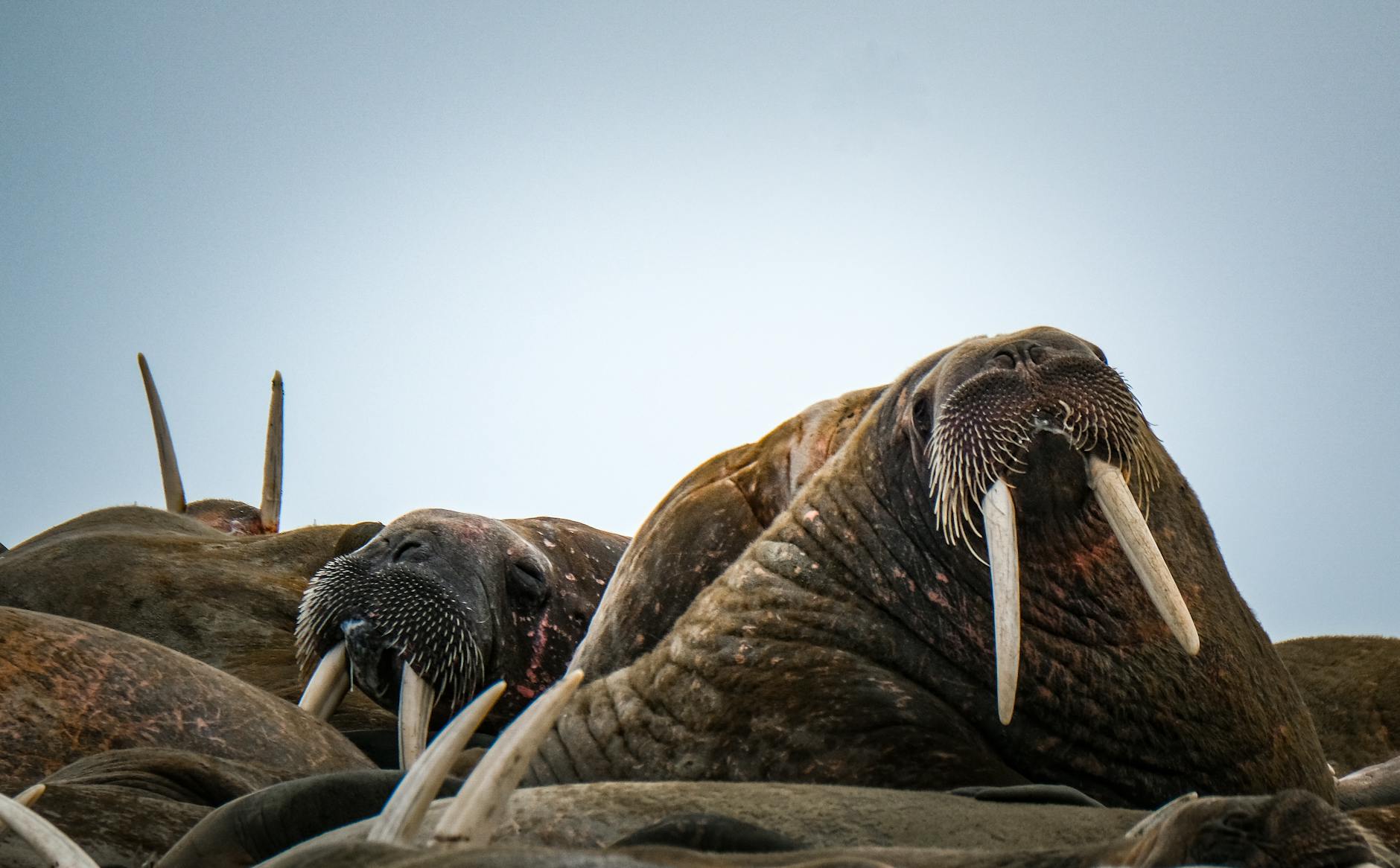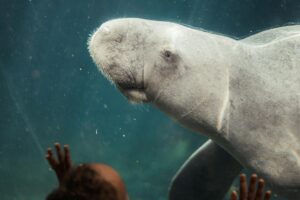Walruses are fascinating creatures of the Arctic. Walruses food habit. Their massive bodies, long tusks, and wrinkled skin give them an intimidating appearance. But are these large marine mammals actually dangerous to humans?
Understanding walrus behavior, their natural defenses and situations where they might pose a threat helps answer this question. Let’s dive into the world of walruses and uncover if they truly pose any danger to us.
Pacific walruses (Odobenus rosmarus divergens) belong to a group of marine mammals known as pinnipeds (pinna, a wing or fin; and pedis, a foot). This group also includes the seals and sea lions.
Walruses are most commonly found in relatively shallow water areas, close to ice or land. In Alaska, their geographic range includes the Bering and Chukchi Seas.
Walruses Food Habit, Life History and Behavior
General description:
Walruses are the largest pinnipeds in arctic and subarctic seas. The genus name Odobenus means “tooth-walker.” Walrus tusks are elongated upper canine teeth both males and females have tusks. Walruses and sea lions can rotate their hind flippers forward to ‘walk’ on them but seals cannot and drag their hind limbs when moving on land or ice.
Walruses are large pinnipeds and adult males (bulls) may weigh 2 tons and the females (cows) may exceed 1 ton. Bulls can be identified by their larger size, broad muzzle, heavy tusks, and the presence of many large bumps, called bosses, on the neck and shoulders.
Food habits:
Walruses feed mainly on invertebrates such as clams and snails found on the bottom of the relatively shallow and rich Bering and Chukchi Seas. Walruses find food by brushing the sea-bottom with their broad, flat muzzles using their sensitive whiskers to locate food items.
Tusks are not used for finding food. Walruses feed using suction formed by pulling back a thick piston-like tongue inside their narrow mouth. Walruses are able to suck the soft parts out of the shells; few hard parts are ingested.
The rejected shells of clams and snails can be found on the sea floor near the furrows made during feeding. Other food items include crabs, shrimps, worms, sea cucumbers, and seals. It is unknown if walruses kill seals or just scavenge seals they find dead.
Life history:
Walrus calves are born in late April or early May during the spring migration. They weigh about 140 pounds (64 kg) at birth. Calves are dependent upon their mothers for at least 18 months and occasionally for as long as 2 1/2 years. Most females do not begin to breed until 6 or 7 years of age.
Mating occurs during January and February, but the fetus does not begin to grow until about mid-June. This delay in fetal development is called delayed implantation and is thought to occur in all pinnipeds.
Although the total period, from conception to birth, is about 15 months, the actual period of fetal growth is about 11 months. Most females do not breed again until the year following the birth of their last calf. Thus, calves are produced in alternate years by females in their prime.
Calves are produced less frequently by older females. By 2 years of age, the young weigh about 750 pounds (341 kg). Females reach their largest weight of approximately 2,000 pounds (909 kg) at the age of 11 or 12 years.
The males continue growing until at least 14 to 16 years of age. Age can be determined by the number of annual rings observed in cross-sections of the teeth.
In the very old animals, some of the rings laid down during the first few years of life are worn away. examination of teeth has shown that walruses live at least 40 years.
Seasonal movements:
Most of the population makes a northward spring migration and southward fall migration that is related to the seasonal advance and retreat of the sea ice.
Several thousand adult males remain in the Bristol Bay area from March through October. These bulls migrate northward in the fall to the St. Lawrence Island area, where they join the rest of the herd to spend the winter and spring in the ice pack.
This is where breeding occurs. Behavior: Tusks are used for displaying and fighting to establish position on ice floes. When jockeying for position on an ice floe walruses will raise their tusks. Walruses with smaller tusks will move away.
Fighting occurs between walruses of similar tusk size and includes brutal jabs with the tusks into the opponent’s neck and body. Tusks are also used for climbing on both land and ice, pushing ice floes to make a space to enter the water and at least in one case as a pick axe.
A female walrus was observed using her tusks to chop a piece of ice to free her calf, which had fallen into a crevasse. Tusks are not used during feeding. The mother-calf bond is very strong and females will not abandon their calves.
Social bonds among other walruses are also present and the calling of a walrus in distress can bring others back to help.
Population size:
The most recent estimate of the Pacific walrus population was ~ 200,000 in 1990.
Recent reductions in the extent, thickness, and duration of the summer sea ice may have profound effects on walrus distribution, movement patterns, and feeding opportunities as less ice is available for a resting platform while feeding.
In 2006, a population survey was conducted by the U. S. Fish and Wildlife Service, U. S. Geological Survey, and agencies in Russia in an attempt at a current population estimate. An estimate is not yet available.
Walruses are not currently listed as ‘threatened’ or ‘endangered’ under the Endangered Species Act, nor are they designated as ‘depleted’ under the Marine Mammal Protection Act.
Predators, hunting, and other mortality: Polar bears prey on walruses by stampeding herds hauled out on land and dragging off calves that get separated from their mothers.
Polar bears will also attack adult walruses in small groups on ice floes. Walruses are also preyed upon by killer whales in areas scarce ice or open water.
Walruses are culturally and nutritionally important to coastal Alaska Natives from Bristol Bay to Barrow although most of the annual harvest occurs near St. Lawrence Island and in the Bering Strait region where walruses are especially important.
Walrus meat, blubber, skin, and organs are used for food. Walrus hide is split and used for boat coverings and ivory is used for carving artworks, jewelry and handicrafts. The lining of the stomach is used to make drums used for traditional dances.
The most favorable period for hunting is during the spring and summer when walruses are passing the villages on their way north.
The U.S. Fish and Wildlife Service monitors the annual harvest and works with the Eskimo Walrus Commission on walrus management issues. Several thousand walruses are harvested annually in Alaska.
Walrus Anatomy and Natural Defenses
Walruses are among the largest pinnipeds, only rivaled by certain species of seals. Adult male walruses can weigh over 4,000 pounds, while females weigh around 2,000 pounds. Their large size alone makes them potentially dangerous. They have long, sharp tusks that can grow up to three feet.
These tusks are not just for show. Walruses use them to defend against threats, establish dominance, and haul their huge bodies onto the ice.
Their thick skin acts as armor. The blubber layer beneath helps keep them warm in freezing temperatures. This thick blubber and skin also protect them from minor injuries. Walruses are incredibly strong.
They can easily crush or injure anything that comes too close. This strength, combined with their tusks, makes them formidable in the wild.
Behavior and Social Structure of Walruses
Walruses are social animals. They gather in large groups, known as herds. Herds often consist of hundreds, and sometimes thousands, of individuals. This grouping behavior provides safety and warmth. Within these groups, walruses are generally peaceful, especially when they are resting or feeding.
However, walruses can become aggressive if they feel threatened. Male walruses, in particular, engage in fights during the breeding season. These fights are usually over mating rights. They use their tusks to challenge and intimidate rivals. Although these fights are rarely fatal, they can cause serious injuries.
When a herd senses danger, it can become chaotic. Walruses may stampede towards the water, crushing anything in their path. In these moments, even other walruses can be harmed. This stampede behavior poses a significant risk for smaller animals and, in rare cases, humans.

Are Walruses Aggressive Toward Humans?
Walruses are generally not aggressive toward humans. They prefer to avoid human interaction. Most walrus encounters with people are peaceful, especially when humans keep a respectful distance. However, there are situations where walruses can become dangerous.
If a walrus feels cornered or threatened, it may react defensively. A mother walrus with a young calf is especially protective. She will not hesitate to defend her offspring if she perceives a threat. In these cases, a walrus can charge at a person or animal, using its massive body and tusks as weapons.
Curiosity can also lead walruses to approach boats or coastal areas where humans are present. If a walrus gets too close, it might accidentally cause damage. Their size alone can overturn small boats or cause damage to structures like docks.
The Dangers of Disturbing Walrus Habitats
Human intrusion into walrus habitats can increase the chances of dangerous encounters. As climate change melts Arctic ice, walruses are forced to adapt.
They rely on ice floes for resting, breeding, and feeding. When ice is scarce, they gather on land in larger numbers, increasing the risk of human interaction.
Large groups of walruses on land are highly sensitive to disturbances. Loud noises, sudden movements, or the presence of vehicles can trigger a stampede. When walruses stampede, they move quickly towards the water, trampling anything in their path.
These stampedes have caused injuries and deaths, not only for other animals but also for humans who happen to be too close.
In recent years, conservationists and local authorities have placed restrictions on human activities in walrus habitats. These restrictions help minimize disturbances, protecting both humans and walruses.
Walrus Encounters in the Water
While walruses are generally less aggressive in water, they can still pose a danger. Walruses are excellent swimmers, using their flippers to move gracefully through the water.
If a walrus feels threatened while swimming, it might react defensively. For instance, divers and swimmers are at risk if they come too close to a walrus or its calf.
Additionally, walruses can easily tip over small boats. They may become curious about boats, especially if the boat is near their feeding grounds. While walruses do not hunt or seek out humans, their massive size and strength make them a risk. In some cases, walruses have reportedly attacked boats, either out of curiosity or perceived threat.
Human-Walrus Conflicts
Human-walrus conflicts are relatively rare, but they do happen. In regions where people hunt walruses for subsistence, there is an increased risk of confrontation. Native communities in the Arctic have long relied on walruses for meat, tusks, and hides. These communities understand walrus behavior and take precautions during hunts.
However, conflicts are more likely when tourists or outsiders venture into walrus territories without knowledge of the animal’s behavior. Some tourists attempt to get close for photos, which can lead to dangerous situations. Walruses, particularly in herds, can feel threatened by unfamiliar sounds or movements.
Conservation Efforts and Human Responsibility
Protecting walrus habitats is essential for both their safety and ours. Conservation organizations are working to preserve Arctic habitats and reduce human impact.
The melting ice due to climate change forces walruses to spend more time on land, increasing the likelihood of human encounters. By minimizing our impact, we can help reduce the risks associated with walrus-human interactions.
Respect for walrus habitats and adherence to regulations are key. Tourists and visitors to the Arctic should observe from a safe distance. Many conservation areas provide specific guidelines for observing wildlife. Following these guidelines helps prevent unnecessary stress for the animals and reduces potential dangers for humans.
Precautions for Safe Walrus Encounters
When in walrus habitats, there are several precautions to keep in mind:
- Keep a Safe Distance: Maintain at least 100 yards (300 feet) from walruses, whether on land or water. This distance reduces the risk of disturbing them.
- Stay Quiet and Avoid Sudden Movements: Walruses are sensitive to loud noises and sudden actions. Keeping calm helps prevent stress and potential stampedes.
- Avoid Encounters with Mothers and Calves: Mother walruses are highly protective. Never approach a mother and her calf.
- Respect Local Regulations and Guidelines: Many Arctic regions have strict rules for wildlife observation. These rules help keep both humans and animals safe.
- Avoid Feeding or Attracting Walruses: Feeding or attracting walruses is dangerous and illegal in many regions. It encourages risky behavior and disrupts their natural diet.
- Stay Informed About Walrus Behavior: Understanding walrus behavior helps visitors act responsibly. Researching before visiting their habitats can make encounters safer.
Conclusion: Are Walruses Dangerous?
Walruses are not naturally aggressive towards humans. However, their size, strength, and defensive behaviors can make them dangerous if they feel threatened. In most cases, walruses prefer to avoid humans. They are generally peaceful animals focused on survival in the harsh Arctic environment.
Respecting walrus habitats and following safety guidelines can prevent dangerous encounters. With the right precautions, humans and walruses can coexist safely. Observing these incredible animals from a distance allows us to appreciate their beauty while protecting both ourselves and the walruses.


